We entered the final stretch for the delivery of Omonia Square, which last year has been fenced off and is not accessible to citizens.
The intention is to remind one of its old form with the fountain, with the crossing for pedestrians that connects the University and Agios Konstantinos to remain. The renovation, costing 500,000 euros, is a donation from the Athanassios K. Laskaridis Foundation to the Municipality of Athens.
As it has become known, the whole of the existing coating (4,500 square meters surface) will be replaced with cold material plates, which will help to reduce the temperature during the summer months, contributing decisively to the environmental upgrade of the square.

According to the plan, new LED technology lighting fixtures will be installed.


According to the urban plan of Athens by Cleanthes and Eduard Saubert, in 1834, the area was initially intended for the construction of the Palaces. But the plan never went ahead. The same thing happened with the next plan of the Bavarian Leo von Klentze, in 1844. His proposal provided for the creation of a small circular square, called Platia Othonos.
The area was finally transformed into a square in 1846 and was initially named Palace Square and then Othonos Square.
In 1862 it was renamed to Unity Square, when the leaders of the opposing political parties gathered and took the oath of "unity" in this space.
In 1895 the outdoor station of the Athens - Piraeus train was created. The first "Omonoia" station was inaugurated on May 17 (the same day as the Monastiraki station) and was an open-air semi-underground station, of the open tunnel type, at the intersection of Lykourgou and Athena streets.
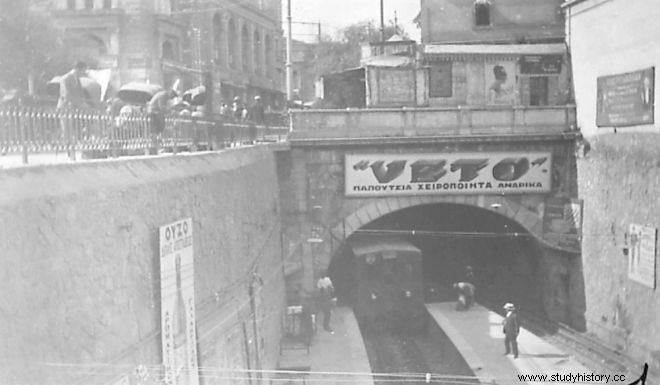
In 1930 the square became circular, pavilions were built for flower sellers and acquired a commercial character.
The layout of the underground space was done in 1954 with the construction of an underground square with banks, shops and the first escalators, while in 1960 the emblematic fountain was added.
In 1988 the glass "Runner", a work of sculptor Kostas Varotsos, was installed, about which we write in more detail below.
The last transformation of the square took place in the period before the 2004 Olympic Games.
The square before the start of work on the construction of the station, January 1928:
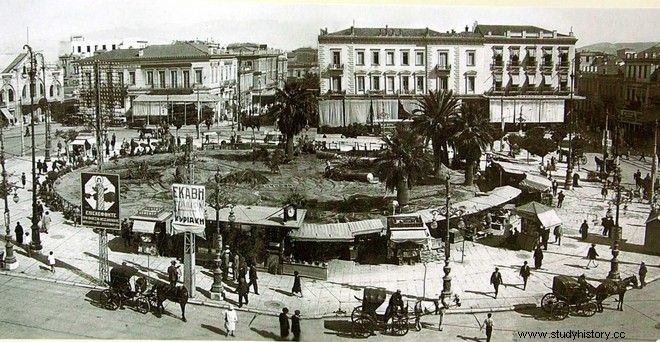
Construction of the Omonia - Attica tunnel, 1928:
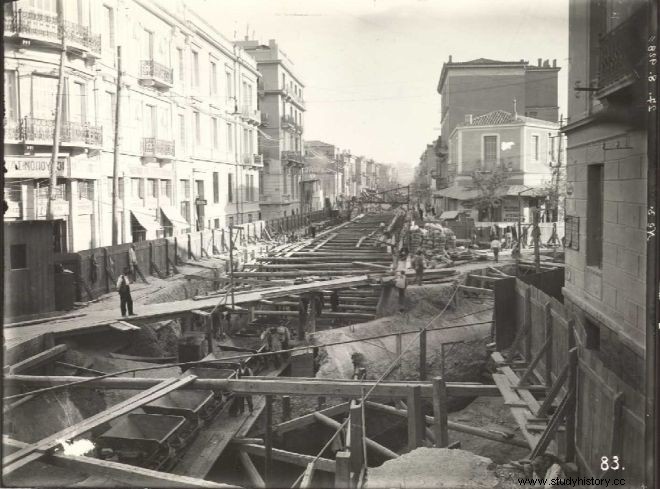
The design of Omonia square on the day of its inauguration on July 21, 1930. The photo is from the archive of ISAP:
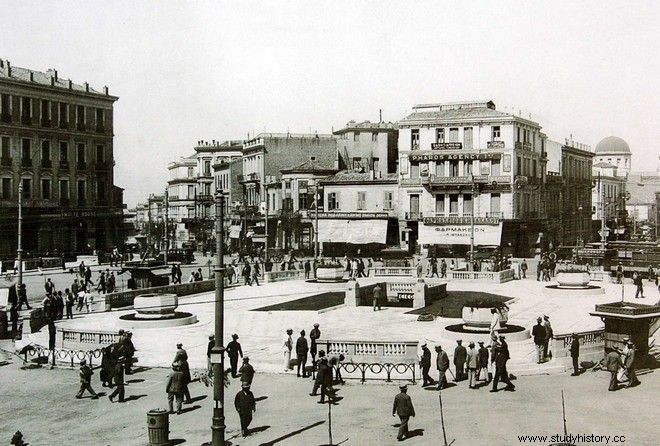
Below is a historical document from the opening of the station. An electric train breaks through the paper sign "July 21, 1930" and enters the station.

Eleftherios Venizelos attends the inauguration of the underground station, 1930:

Xmas decoration in the square in 2001:
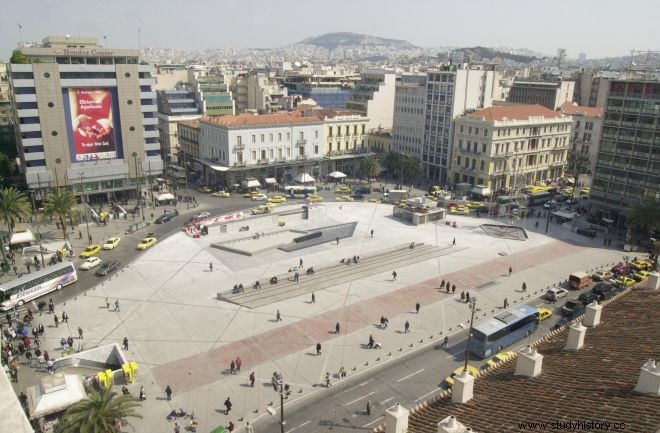
Omonoia when completed in 2003:

The Pentacycle
The sculptor Giorgos Zongolopoulos has associated his name with Omonia Square.
Sculptor Giorgos Zongolopoulos' relationship with Omonia Square begins in 1958, when he was jointly awarded with the architect K. Bitsios the 1st and 3rd prizes in the Panhellenic Architectural and Artistic competition announced by the then Ministry of Transport and Public Works for the configuration of the square.
The composition of Omonia Square in 1958 included an outer circle that enclosed a smaller isosceles hexagon, inside which was an isosceles pentagon. In this pentagon was placed a water sculptural composition consisting of jets that formed a water diagonal arc that impinged on a water wall and a water column 18.00 meters high. Opposite this water column, the sculptural composition provided for the placement of a sculpture entitled "Neptune".
In the outer space between the circle and the hexagon, a composition consisting of colored pebbles was initially planned, but this was not realized and a lawn was installed in its place.
The project was carried out and inaugurated in 1960, with the familiar water jets, but the integral sculpture "Poseidon" was never placed in Omonia Square.
Then various interventions were made, the sculpture "Runner" by Kostas Varotsos was placed and finally in the context of the new configuration of Omonia Square, after a competition conducted by the company "Unification of Archaeological Sites S.A." in 2001, the hydrokinetic sculpture of Giorgos Zongolopoulos entitled "Pentacycle", which represented Greece at the Venice Biennale in the same year, was placed in the square, where it still stands today.
Dromeas, a work by Kostas Varotsos, was created in August 1988 as part of the artistic activity "Dromena" organized by the municipality of Athens under mayor Miltiadis Evert and deputy mayor for culture Stavros Xarhakos. The statue was initially placed in Omonia square, where it remained until the beginning of the works for the metro station, when it was moved to the place where it is still today, in Megali tou Genous School square, in front of the Hilton hotel:
The sculpture is located east of the square between Panepistio and Stadiou streets in a specially designed water tank, it is 15 meters high, it is made of stainless steel and consists of a cruciform structure with five circles which move with the help of water.
The hydrokinetic function of the sculpture remained incomplete for a number of years, as the water supply had been interrupted. An exception is a short period of time (2008 to early 2009), during which the project was maintained in collaboration with the Municipality of Athens and operated hydrodynamically, as its creator had planned.

The work that was not done
The model of the exhibition "Rethink Athens:Athens in the center" for Omonia. It was the proposal of the Onassis Foundation that was delivered in 2014. According to this plan, the square would recover the square of its neoclassical design, its central plateau would have trees and water features while table seating was also planned. The ambitious plan did not proceed due to lack of community funding in the midst of a crisis.
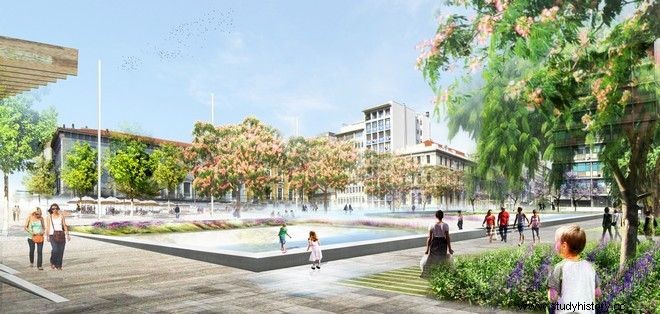
The square as it will be today with the large circular fountain in the middle:


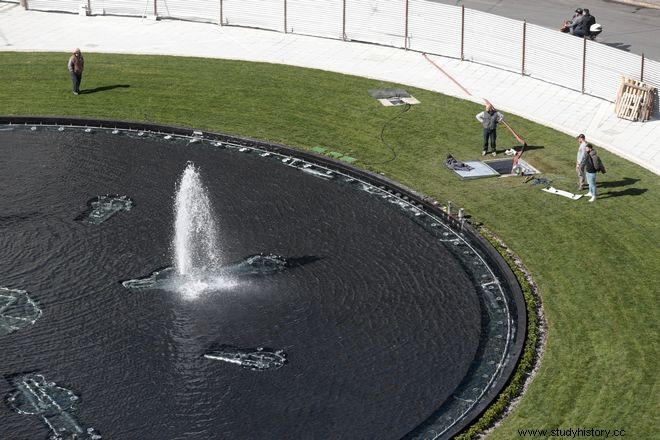
Varotsos has said about the Runner of Omonia Square:
"What I had in mind was the idea of the passerby. Omonia was always a starting point. All the provincials and all the foreigners came and come to Omonia. What interested me was the figure of the man who is in constant motion .A stranger you just meet, you ask him:"When did you come?" and immediately after that you ask:"When are you leaving?". This man then developed into a Runner. The Runner's case was something that gradually changed the image of the city, which began to acquire a reference point.
The Evert-Xarhakos duo had achieved the impossible. They had managed to inspire the employees of the Municipality, who volunteered to help in the construction of the project every night. After seven in the evening all the staff of the spiritual center of the Municipality went down to Omonia and one was cutting glass, another was cleaning, another was transporting.

In 1993 we were notified by the metro that they wanted to dig right where the Runner stood. That's when we had to tear him down because he wasn't made to be transported. It was preceded by several discussions with the company Bechtel, which had undertaken to build some of the subway lines. What the company officials told me was that they would tear down the project and rebuild it somewhere else. After all, their contract with the Greek government stated that whatever they broke, they would rebuild it. And so it happened. The play was rebuilt from scratch in 1994 at the Hilton".
